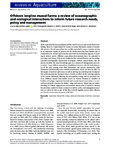Offshore longline mussel farms: a review of oceanographic and ecological interactions to inform future research needs, policy and management
| dc.contributor.author | Mascorda Cabre, Llucia | |
| dc.contributor.author | Hosegood, Phil | |
| dc.contributor.author | Attrill, Martin | |
| dc.contributor.author | Bridger, Danielle | |
| dc.contributor.author | Sheehan, Emma | |
| dc.contributor.other | Faculty of Science & Engineering | en_US |
| dc.date.accessioned | 2021-03-21T13:41:32Z | |
| dc.date.available | 2021-03-21T13:41:32Z | |
| dc.date.issued | 2021-03-15 | |
| dc.identifier.uri | http://hdl.handle.net/10026.1/16967 | |
| dc.description.abstract |
With a growing human population and the need to protect our oceans from over-fishing, there is a requirement for society to source alternative means of sustain-able protein. Mussel aquaculture has rapidly expanded in many countries serving as an important supply of protein, but its development has been limited due to competition for coastal space and the associated environmental impacts of farming in inshore waters. Offshore aquaculture developments have the potential to overcome such issues. This review synthesises the current literature on the ecological and oceanographic interactions of longline offshore mussel farms with the aim to elucidate the main knowledge gaps in a context of management and conservation. Large offshore aquaculture installations interact with the hydrodynamics of the area causing water flow distortions and current attenuation, wake formation and distorting water column stratification which can have an effect on the supply of nutrient and seston as well as altering material dispersal, biodeposition and resuspension, having in turn, a knock-on effect on the carrying capacity of the system, ultimately affecting the surrounding ecology and its ecosystem services. Offshore mussel farm studies report an increase biomass or numbers of benthic and pelagic organisms beneath and around mussel ropes relative to control sites using the structure for shelter, refuge and nursery. Improving our under-standing of offshore aquaculture–environment interactions is crucial to identify the priorities needed for future research to inform policy and management practices as well as its role as part of the Blue Growth Agenda and as ‘other effective area-based conservation measures’ (OECMs). | en_US |
| dc.description.sponsorship | Offshore Shellfish Ltd | en_US |
| dc.language.iso | en | |
| dc.publisher | University of Plymouth | en |
| dc.relation.uri | https://onlinelibrary.wiley.com/doi/10.1111/raq.12549 | en_US |
| dc.subject | aquaculture | en_US |
| dc.subject | blue growth | en_US |
| dc.subject | ecology | en_US |
| dc.subject | marine protected areas | en_US |
| dc.subject | mussel farm | en_US |
| dc.subject | oceanography | en_US |
| dc.title | Offshore longline mussel farms: a review of oceanographic and ecological interactions to inform future research needs, policy and management | en_US |
| dc.type | Article | en_US |


